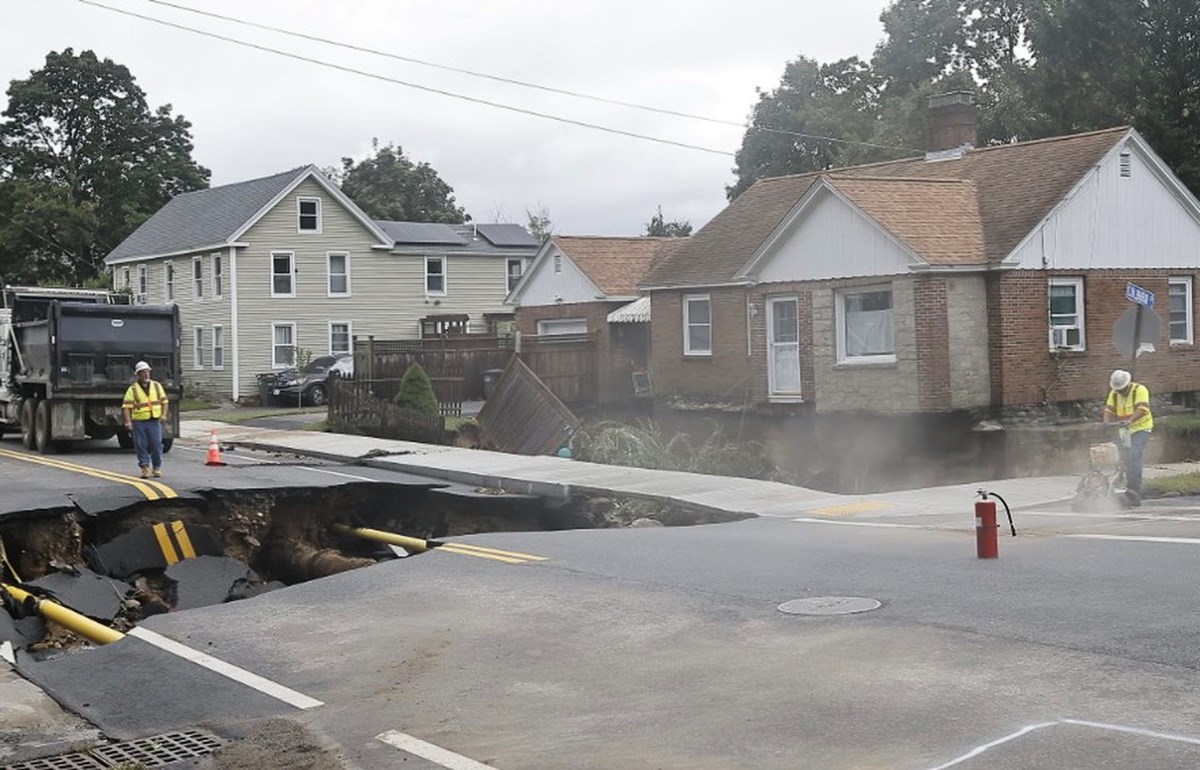Without addressing the cause of climate change, we can’t build or innovate our way out of the ever-increasing impacts that will come.
 Image by The Boston Globe/Lane Turner
Image by The Boston Globe/Lane Turner
Crews worked after a torrent of water washed out the intersection of Pleasant and Colburn streets in Leominster, leaving a house there an island on its own foundation, Sept. 12.
09/15/2023
The Boston Globe
By Mathew Barlow and Juliette N. Rooney-Varga
But they are not unexpected. Well-established science and years-old projections connect the dots between the past few weeks’ extreme storms and flooding in Massachusetts, Vermont, Libya, Greece, India, China, and Brazil. These events have devastated communities and entire regions across the world and caused thousands of deaths. Historically, the heaviest rain events in New England were associated with rare hurricanes. But now, human-induced climate change is also supercharging our day-to-day weather, and we’re starting to see what that looks like, here and around the world.
The words “unprecedented” and “new normal” are used in more and more reports about extreme weather. But the events we see now will not be a new normal if emissions from burning fossil fuels and wood continue unabated. Instead, without emissions cuts, storms and other extreme events will continue to intensify — as will their devastating consequences. Today’s unprecedented damage will be tomorrow’s good old days.
Heavy rain and flooding occur naturally. But the growing frequency and intensity of storm events are a direct result of human-caused climate change. Burning coal, oil, natural gas, and wood emits carbon dioxide to the atmosphere, where it builds up and traps heat. Both the earth’s surface and the lower atmosphere are warmer than they used to be. A warmer ocean and land surface cause more water to evaporate into the air. And warmer air can hold more water. Like a bucket that spills when it is filled with water, rain events happen when air is saturated with water. Warming the air makes the bucket bigger, resulting in heavier rain and a more intense water cycle.
New England is a hot spot for intensifying rainfall in a warming world. Data collected over the past few decades have shown that this intensification is already happening. These impacts have been expected since the 1960s, based on both physical reasoning and model projections, including the pioneering modeling work of Syukuro Manabe, which was recently acknowledged with a Nobel Prize.
In general, the intensification of heavy rain will grow as long as fossil fuel emissions continue, making the flooding like that in Leominster and around the world more and more frequent. Almost all of the world’s countries, including the United States, signed the Paris climate agreement in 2016, with a stated goal of limiting global warming to 2 degrees Celsius or less. If the goal is met, the intensity of rainfall would continue to increase moderately for a few decades and then level off. But to stabilize rainfall intensity and the global climate, the amount of carbon dioxide in the atmosphere must be stabilized. Like water pouring into a bathtub, carbon dioxide continues to build up in the atmosphere as long as it is emitted. So, to get to a stable “new normal,” the tap on emissions needs to be turned off. If the global community meets its plans and pledges, extreme events will stabilize; if the global community continues to move slowly, extreme events will continue to increase in intensity and frequency.
What can be done? We need to stop making things worse and reduce the harms from the changes that are already happening. Harm reduction includes actions such as investing in more resilient public infrastructure, including permeable surfaces and public transportation; restoring wetlands; and strategically removing dams. But without addressing the cause of climate change, we can’t build or innovate our way out of the ever-increasing impacts that will come. The recent flooding events show just some of the scope of impacts that occur with only a little more than 1 degree Celsius of warming so far, as well as how the impacts fall hardest on those with the fewest resources and least responsibility for the problem.
Recent federal and state incentives mean that citizens can improve their comfort while cutting the cost of living and emissions at the same time. Insulating and weatherizing homes, switching from furnaces to heat pumps, and switching from internal combustion engine cars to active or public transit or electric vehicles will save money and reduce emissions over time. Perhaps most important, policy makers need to hear that climate action that improves lives is a top priority — not an afterthought.
We can choose to live with intensifying climate damage out of complacency or despair, or we can choose to work toward a better future that is not yet out of reach. The devastating flooding events in Leominster and across the world should serve as our call to action on both cutting emissions and building resiliency to extreme events.
